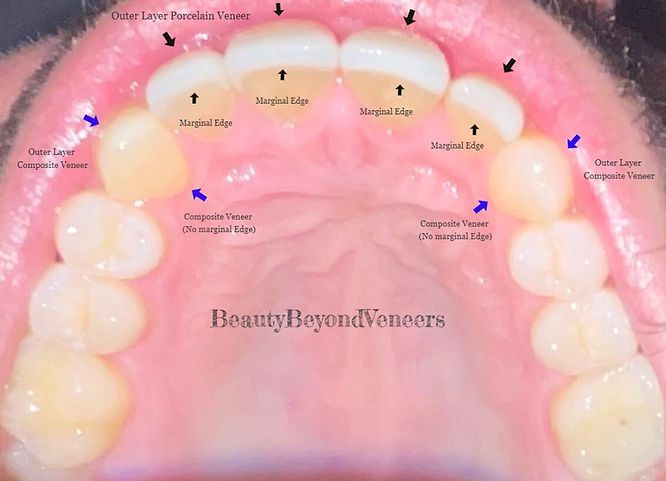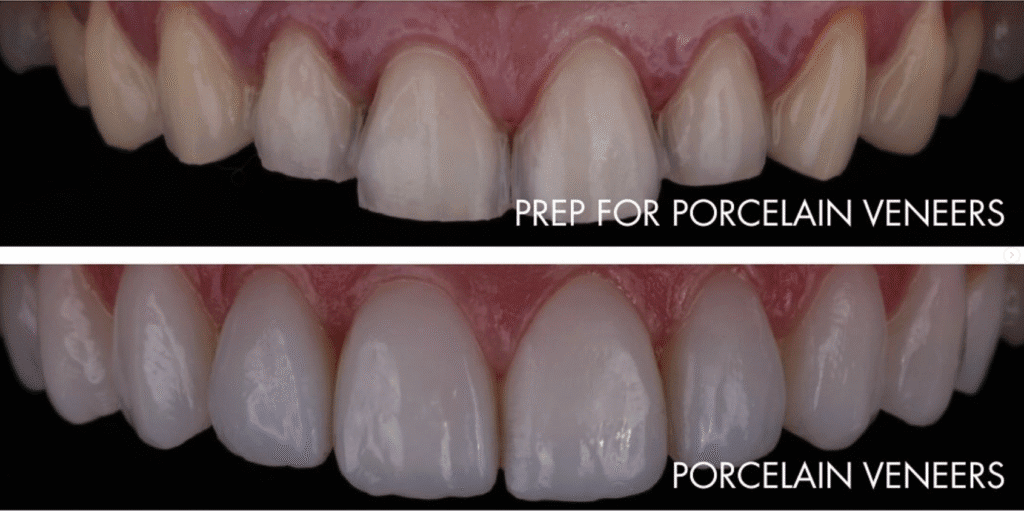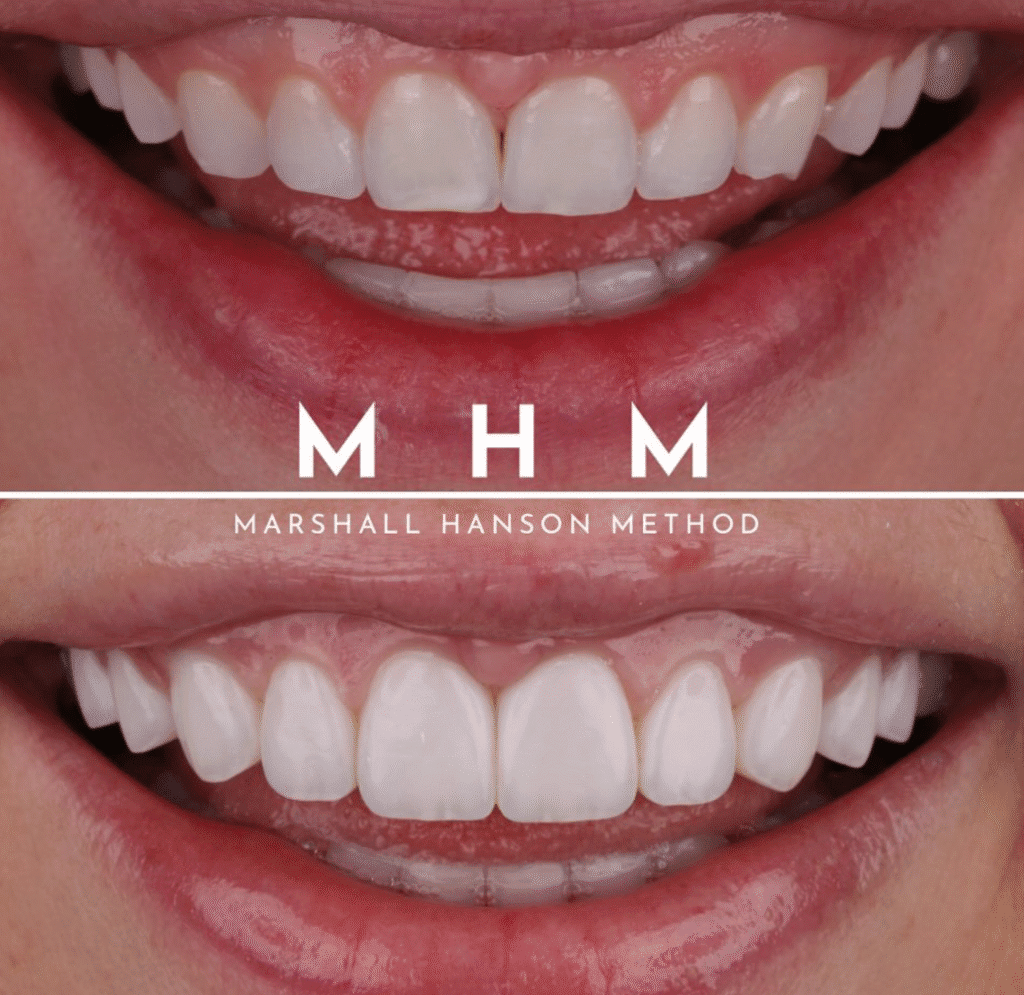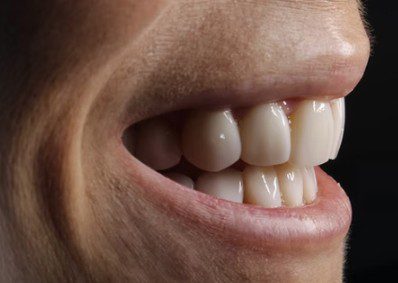The glossy after photos of porcelain veneers are everywhere. Perfectly white, perfectly shaped, and sold as a quick path to confidence. But those pictures only show one side of the story.
What patients rarely see is what teeth look like under veneers once the smile is stripped back. And that part of the truth is far less glamorous.

What Dentists Do Before Placing Veneers
Porcelain veneers are not simply placed on the front of your teeth like a press-on nail. To make them fit properly without appearing bulky, most dentists must first remove enamel, often more than patients expect.
This reshaping process permanently alters the tooth. In some cases, the teeth are filed down so much that they resemble sharp pegs or “shark teeth.”
While this level of reduction is typically associated with crowns, some cosmetic dentists apply similar levels of shaving for veneers. Why? Because it makes placement easier and helps them achieve their ideal aesthetic results, even if it means removing more tooth than necessary.

In this article, we will show examples of different preparation levels and explain why, in our opinion, truly healthy teeth should never be shaved at all. Unfortunately, what is happening in practice tells a different story.
If you are thinking about no prep veneers and want to understand the truth beyond the marketing, keep in mind that only 5 to 10 percent of people are truly good candidates. Some experts believe the actual number may be even lower.
Read our full guide: No Prep Veneers: The Deceptive Smile Solution That Locks You In for Life.
The Hidden Reality Underneath
When the veneers come off, patients are often shocked. Here is what is usually revealed:
- Filed down – The natural enamel is ground away, leaving shortened stubs that no longer resemble full teeth
- Weakened – Without protective enamel, teeth are more sensitive and vulnerable
- Dependent – Once shaved, your teeth cannot function normally without veneers covering them
This is why veneers are irreversible. Once your enamel is gone, you cannot get it back. Every 10 to 15 years, veneers must be replaced, which means further adjustments and more risk to what remains of your natural teeth.
Marketing for veneers focuses on the after – the bright and perfect smile that sells the procedure. But what teeth look like under veneers is almost never shown. Why? Because if patients saw the reality, the drilled and ground-down teeth, many would think twice before saying yes.
Glossy photos are persuasive. They rarely show the process itself or the permanent stubs left behind. This is why patient education is so critical.
What Do Teeth Look Like Behind Porcelain Veneers Once They Are Already Placed?
Patients often ask, what do teeth look like behind veneers? The answer can be unsettling. Behind the porcelain shells are teeth that have been shaved down, etched, and permanently altered. They no longer look like natural, full teeth. Instead, they appear reduced and fragile, fully dependent on the veneers covering them.
Contrary to popular belief, porcelain veneers aren’t merely bonded to the front surface of a tooth like a sticker. In reality, the porcelain often wraps under and behind the tooth, altering its structure significantly.

As evident in clinical images, porcelain veneers can cover both the front and back surfaces of the teeth, not just the visible front as commonly advertised.
The degree to which the porcelain extends behind the tooth’s surface varies, but it’s believed to be at least 20%, sometimes more depending on the type of porcelain used.
This wrapping effect can impact speech, chewing function, and create a lingering sense of foreignness in the mouth, especially where the bottom edge of the veneers interacts with the lower teeth.
What Do Teeth Look Like Before Veneers Are Placed?
After veneers are removed, or before the final set is permanently placed for the first time, the underlying teeth are exposed and permanently altered. Because enamel was shaved away during the preparation process, the natural teeth can appear smaller, flatter, or in some cases, sharply reduced.
They are often more sensitive, more vulnerable to damage, and cannot function the same way they did before. The original structure of the tooth is lost, and it cannot grow back.
This is why veneer removal is not a return to your natural smile, but rather an uncovering of a now dependent, altered foundation. This hidden step is rarely shown, which is why before and after photos can be misleading. They do not reveal the permanent cost in between.


In many cases, dentists remove healthy tooth structure that did not need to be altered, and often recommend veneering four, eight, or even ten teeth to achieve a specific aesthetic result, a choice that often reflects profit over patient care.

Most dentists agree that veneers need to be replaced every ten to fifteen years. Each replacement involves additional adjustments, which can increase the risk to what is left of your natural teeth.
Veneer marketing focuses heavily on the final result, the bright and flawless smile that helps sell the procedure. But the reality of what teeth look like underneath is rarely shown. If more patients saw the drilled and reduced teeth behind the porcelain, many would pause before moving forward.
Polished photos are persuasive, but they often leave out the preparation process and the irreversible changes. This is why patient education is essential.
The Problem with No Prep Veneers
Some dentists promote no prep or minimal prep veneers as if they are reversible. They are not. Even without aggressive drilling, the bonding process is permanent. Once a veneer is attached, your tooth is no longer in its natural state. The surface is etched, treated, and altered in a way that makes it impossible to go back.
Even so-called no prep veneers will always require a veneer on top to protect the modified tooth.

Worse still, many dentists claim they are doing minimal prep when in reality they perform traditional veneer preparation.
Patients are told only a little enamel will be removed, but in practice far more can be drilled away. And there is no reliable way for the patient to verify how much enamel was lost unless the veneer is removed and the damage is already done.
👉 To learn more, read: No Prep Veneers The Deceptive Smile Solution That Locks You In For Life
The Better Option Most Dentists Overlook
Enhanced composite resin veneers can be used for anyone, whether your teeth are severely damaged or perfectly healthy. When performed correctly by skilled dentists such as Dr. Marshall Hanson, this method has even replaced porcelain veneers with outstanding results.
Unlike porcelain, it is additive, meaning it builds on top of your natural teeth and does not require the removal of enamel.
To understand the difference between traditional composites and the newer enhanced options, read our full guide here: Composite Resin Veneers Explained.

For those seeking a smile upgrade without sacrificing natural structure, there are safer steps to consider before porcelain and even enhanced composite resins . Whitening alone can often brighten a smile. If alignment is the concern, Invisalign or braces can create improvements without enamel loss.
For small chips or uneven edges, enhanced composite resin offers a natural next step that preserves tooth structure while improving aesthetics.
Even if traditional bonding needs replacing, moving straight to porcelain veneers can feel like an unnecessarily aggressive next step. This concern is often shared in our r/porcelainveneerstruth community
Too many dentists market porcelain as the final fix, when in reality it is a lifetime subscription model that forces you to replace veneers every ten to fifteen years while losing more and more of your natural tooth structure.
Why Porcelain Veneers Are So Heavily Promoted
It is important to recognize why porcelain veneers are pushed so aggressively. For many dentists, they are one of the most profitable procedures, with fees reaching tens of thousands of dollars for a full set.
By locking patients into a cycle of replacements, dentists create a steady stream of revenue that can last for decades.
While veneers do serve a legitimate purpose for teeth that are severely unhealthy, badly stained, or fractured in multiple places, they are often marketed to people with small chips on otherwise healthy teeth or for minor bonding touch-ups that a dentist may not want to redo.
This practice has become an epidemic in Hollywood, where even the smallest imperfections are treated with aggressive veneer procedures.
You can read more about how this trend has been glamorized in celebrity culture here: Beneath the Veneer: The Dark Side of Celebrity Porcelain Veneers Before and After Pictures.
Final Thoughts
IIf you are considering veneers, do not only look at the glossy before and after photos. Ask the hard questions: What do teeth really look like under veneers? Are my teeth already healthy, and do I want to be locked into relying on porcelain for the rest of my life? Once you understand the truth, you may realize the cost is far greater than the smile on the surface.
Veneers are not a harmless beauty trend. They are an irreversible procedure that changes your teeth forever. Before agreeing to something permanent, explore safer options like whitening, orthodontics, or enhanced composite bonding.
Protect your enamel, ask tough questions, and do not let filtered beauty standards convince you to sacrifice what is already working.

Already got porcelain veneers and dealing with regret? You are not alone. Learn how to move forward:
Porcelain Veneer Regrets: The 10 Pillars of Moving Forward
If you have questions about this article, need help understanding your options, or want to know what to ask during a consultation, we’re here to help. Just leave us a message — even a quick question like:
- “Do you know any qualified dentists who offer enhanced composite resin veneers?”
- “How do I know if this is right for me?”
- “What are the typical costs among providers for enhanced composite resin veneers?”
- “What should I ask my dentist before starting treatment?”
- “Is there a way to tell if my teeth are healthy enough for this type of veneer?”
- “What’s the difference between traditional bonding and enhanced composite resin?”
Every person’s case is unique, and while we’ll do our best to answer your questions and share helpful insights, always consult a licensed dental professional before making any treatment decisions.
Disclaimer:The information provided is for educational and informational purposes only and does not constitute medical or dental advice.





